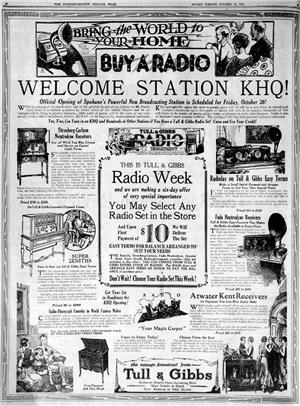On October 30, 1925, KHQ radio makes its Spokane debut in a four-hour broadcast extravaganza. KHQ had been in existence since 1922 in Seattle, but owner Louis A. Wasmer (1892-1967) moves the transmitter to Spokane in the summer of 1925 in order to re-launch the station at 1,000 watts. This is a powerful signal for that era, and Spokane embraces the prospect of a station that can reach the entire Northwest. Wasmer spends several months building a broadcasting room, aerial, and studio. The station's highly anticipated launch features speeches by dignitaries, music by local bands and orchestras, and vaudeville-style comic sketches. Listeners pick up the signal from as far away as Minnesota and California. KHQ immediately becomes Spokane's top radio station and later becomes the region's NBC radio network affiliate. By 1984, the KHQ call sign will exist only on television.
Front Page News
The imminent arrival of KHQ Radio had been front-page news in Spokane ever since August 1925, when Wasmer and his partner, Frank (Sparkplug) Buhlert, announced the move from Seattle to Spokane. Wasmer was one of the best-known radio engineers in Seattle, and Buhlert one of the best-known radio voices. They described their move to Spokane as an opportunity to relaunch KHQ at 1,000 watts in a prime geographic location.
Spokane gave KHQ a reception that bordered on the delirious. Five days before the launch, The Spokesman-Review published a 10-page special section devoted to KHQ and "the most modernly equipped" broadcasting station "on the continent" ("KHQ, Spokane's New Radio Station"). The broadcasting room was on the top floor of the seven-story Peyton Building, with the antennae on the roof above, on two 70-foot masts. The main studio was across the street, in suites 427 and 428 of the luxurious Davenport Hotel.
The city's merchants – especially those who sold radios – were even more fulsome in their praise. "WELCOME STATION KHQ!" trumpeted the Tull & Gibbs department store in a full-age ad. "With the raising of the masts above one of the greatest broadcasting stations on the Pacific coast, there is unleashed a medium by which news of the Inland Empire and its advantages will be flung to greater distances – 1,000 watts of power will be the voice of our community, a voice that is melodious, friendly, HUMAN ... KHQ undoubtedly opens the doors to greater good will – it will be a new force in educational matters – thousands upon thousands of homes will echo to its sounds -- thousands upon thousands will dance to its music" (Tull & Gibbs ad).
The launch extravaganza ran from 8 p.m. to midnight. It began with a message from Governor Roland Hartley (1864-1952), who said he wished he could have been in the studio in person, to shake hands "with those men whose energy and enterprise have put Spokane and the Inland Empire definitely on the aerial map" ("KHQ's Debut Big Success"). A long list of dignitaries followed with remarks, including Lieutenant Governor Lon Johnson, the president of Gonzaga University, and the president of the Spokane Chamber of Commerce.
Spokane's symphony orchestra, conducted by Leonardo Brill, played a Viennese waltz and other classical pieces. Spokane's resident theatrical company, the Maylon Players, performed two ensemble numbers. The football captains of Gonzaga University and the Haskell Institute gave brief remarks about the upcoming game between the two teams. Numerous piano soloists performed. The Davenport Hotel's 11-piece jazz orchestra played dance music.
During an intermission, Buhlert made an enticing offer to KHQ's far-flung listeners. He said that everyone who sent in a telegram -- detailing where they were listening and the quality of the signal – would receive small souvenir bags of lead ore from the Bunker Hill & Sullivan Mine in the Coeur d'Alene district. More than 300 telegrams poured in, proving that the signal was picked up all over Washington and Oregon, and as far away as St. Paul, Minnesota. This was despite the fact that the debut broadcast was going out at only 500 watts -- it would take a few more weeks to ramp up to the full 1,000 watts.
"Unique in its Perfection"
Buhlert had vowed to make this debut "a memorable event in Spokane's radio history" and he evidently made good on that promise ("New Radio Will Make Bow Tonight"). The headline in The Spokesman-Review the next morning read, "KHQ's Debut Is Big Success." A reporter declared the reception to be "unique in its perfection" ("KHQ's Debut Is Big Success"). This would be the first of many triumphs for fledgling station. In fact, on its one-year anniversary, KHQ staged an even more elaborate event, an unprecedented 10-hour, all-night, live broadcast.
In 1927, KHQ became one of the founding affiliates of NBC Radio's Orange Network, which linked the big stations on the West Coast with the national network. KHQ would subsequently carry many of the famous programs of the Golden Age of radio, including Orphan Annie, Amos 'n' Andy, The Jack Benny Show, and The Fred Allen Show.
However, when TV arrived and blunted the power of network radio, KHQ radio went into a slow decline. It would eventually convert to an adult contemporary music format and change its call letters to KLSN. The station later went through a succession of owners, formats, and call letters. Today, only KHQ-TV, Spokane's NBC television affiliate, carries the KHQ call sign.

